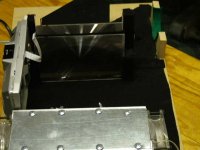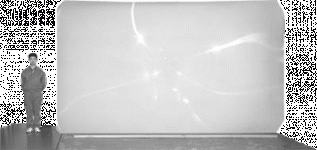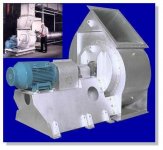Yeah dude it is. but like I said before, use it as reference only, cause the theory isnt great for rays that far from the center of the lens. It should give you some good guidelines to play around with though.
yah in my light engine...the condesor is almost 30 mm from the arc already....I am just gonna play around with moving the light box to see if it changes the brightness...
thanks for all your help
now to order some UV glass.....
thanks for all your help
now to order some UV glass.....
Your image will be clearer if you can control the reflection of light off various surfaces. So you could paint the corian with flat black paint. Even better: Glue black felt onto it.
Is this what you ment...I went and purchased some black felt and went to town....hows it look???
Attachments
black felt
>hows it look?
It looks great. I can't see anything in there! Perfect.
Just make sure the felt is not near the lamp, without some aluminum in between. Don't want to start a fire!
>hows it look?
It looks great. I can't see anything in there! Perfect.
Just make sure the felt is not near the lamp, without some aluminum in between. Don't want to start a fire!
condensor & hot mirror holder
If you are using a piece of aluminum to hold your condensor lens, then you can just stick four of the 50 mm square hot mirror tiles between the aluminum and the bottom of the condensor lens. Maybe add some little partly punched out tabs around the outside edges to hold the tiles in place. Then clamp the lens down gently. That will also hold the hot mirror tiles in place.
When you use a condensor lens, you should experiment to find the best position: Put a piece of white paper in place of the condensor fresnel. Then put on your welding goggles and fire up the lamp. Move the condensor lens toward and away from the lamp to see the bright circle of light it throws on the paper. The best position is where the circle is just a bit larger than the diagonal size of the fresnel, so it lights up the corners.
If the condensor lens has to be more than a couple of centimeters from the lamp, then you need a different condensor lens. The whole point of using a condensor lens is to capture as much light as possible and direct that to the LCD. It has to be close to the lamp to do that.
If you are using a piece of aluminum to hold your condensor lens, then you can just stick four of the 50 mm square hot mirror tiles between the aluminum and the bottom of the condensor lens. Maybe add some little partly punched out tabs around the outside edges to hold the tiles in place. Then clamp the lens down gently. That will also hold the hot mirror tiles in place.
When you use a condensor lens, you should experiment to find the best position: Put a piece of white paper in place of the condensor fresnel. Then put on your welding goggles and fire up the lamp. Move the condensor lens toward and away from the lamp to see the bright circle of light it throws on the paper. The best position is where the circle is just a bit larger than the diagonal size of the fresnel, so it lights up the corners.
If the condensor lens has to be more than a couple of centimeters from the lamp, then you need a different condensor lens. The whole point of using a condensor lens is to capture as much light as possible and direct that to the LCD. It has to be close to the lamp to do that.
Re: condensor & hot mirror holder
If the light is not hitting the fresnel at the right angle, it doesn't matter how much light is hitting it, cause its not going to create a plane wave, and will more likely deteriorate the quality of the image rather than improve it. Unless the incoming rays incident of the fresnel appear to be coming from a point source at its focal length, they are useless.
Agreed. But given a condensor of diameter d and focal length f, there is only one position where it will satify the above condition, and that may not be within a few cm.
Guy Grotke said:The best position is where the circle is just a bit larger than the diagonal size of the fresnel, so it lights up the corners.
If the light is not hitting the fresnel at the right angle, it doesn't matter how much light is hitting it, cause its not going to create a plane wave, and will more likely deteriorate the quality of the image rather than improve it. Unless the incoming rays incident of the fresnel appear to be coming from a point source at its focal length, they are useless.
Guy Grotke said:
If the condensor lens has to be more than a couple of centimeters from the lamp, then you need a different condensor lens. The whole point of using a condensor lens is to capture as much light as possible and direct that to the LCD. It has to be close to the lamp to do that.
Agreed. But given a condensor of diameter d and focal length f, there is only one position where it will satify the above condition, and that may not be within a few cm.
I agree, mostly
If you want the light coming out of the condensor fresnel to be parallel, then the condensor lens has to go in the position where it's effective diameter intersects the cone of light that would go from a point-source light at the focal point to the fresnel. So the fresnel "sees" the light as coming from its focal point. Your drawing on the last page of the fresnel setup illustrated that nicely.
You can calculate that position with similar triangles, or you can just make a good full-scale drawing of the fresnel's focal point cone, and measure the distance where the condensor lens will fit.
Then move the lamp toward the condensor lens until all of the fresnel's corners are lit. You could calculate the lamp position, or do a ray drawing to figure it out, but that would be just an estimate. The lamp arc is not a point source, so it gets a bit messy.
But there are situations where you don't want the light coming out of the fresnel to be parallel. For example, your field fresnel may not be a perfect match for the LCD-to-projection-lens distance. So you then would adjust the position of the condensor lens to simulate a lamp not at the focal distance of the condensor fresnel. The rays coming out of the condensor fresnel then would be diverging or converging. That would change the location where the field fresnel focusses the image of the lamp arc. And that can be used to get most of the light into your projection lens.
If you want the light coming out of the condensor fresnel to be parallel, then the condensor lens has to go in the position where it's effective diameter intersects the cone of light that would go from a point-source light at the focal point to the fresnel. So the fresnel "sees" the light as coming from its focal point. Your drawing on the last page of the fresnel setup illustrated that nicely.
You can calculate that position with similar triangles, or you can just make a good full-scale drawing of the fresnel's focal point cone, and measure the distance where the condensor lens will fit.
Then move the lamp toward the condensor lens until all of the fresnel's corners are lit. You could calculate the lamp position, or do a ray drawing to figure it out, but that would be just an estimate. The lamp arc is not a point source, so it gets a bit messy.
But there are situations where you don't want the light coming out of the fresnel to be parallel. For example, your field fresnel may not be a perfect match for the LCD-to-projection-lens distance. So you then would adjust the position of the condensor lens to simulate a lamp not at the focal distance of the condensor fresnel. The rays coming out of the condensor fresnel then would be diverging or converging. That would change the location where the field fresnel focusses the image of the lamp arc. And that can be used to get most of the light into your projection lens.
But there are situations where you don't want the light coming out of the fresnel to be parallel. For example, your field fresnel may not be a perfect match for the LCD-to-projection-lens distance. So you then would adjust the position of the condensor lens to simulate a lamp not at the focal distance of the condensor fresnel. The rays coming out of the condensor fresnel then would be diverging or converging. That would change the location where the field fresnel focusses the image of the lamp arc. And that can be used to get most of the light into your projection lens.
........ and give you projected rings in your image.
Trev🙂
rings in image
Interesting. The only time I have seen rings on my screen was when I moved the projection lens so it focussed on the fresnel instead of the LCD. But I take it you are not talking about the fresnel ring pattern.
Maybe I have not tried moving my condensor fresnel far enough from the focal length distance from the lamp to see this. In my projector, it is about 10 mm past the 220 mm focal length distance, and I see a very nice image. No rings that I can see with any image or test pattern. A 15 inch diagonal 220 mm fl lens is very strong. You get big differences in the light on the other side just by moving it a few millimeters.
Interesting. The only time I have seen rings on my screen was when I moved the projection lens so it focussed on the fresnel instead of the LCD. But I take it you are not talking about the fresnel ring pattern.
Maybe I have not tried moving my condensor fresnel far enough from the focal length distance from the lamp to see this. In my projector, it is about 10 mm past the 220 mm focal length distance, and I see a very nice image. No rings that I can see with any image or test pattern. A 15 inch diagonal 220 mm fl lens is very strong. You get big differences in the light on the other side just by moving it a few millimeters.
The only time I have seen rings on my screen was when I moved the projection lens so it focussed on the fresnel instead of the LCD.
Yeah thats normal, thats why we dont have the top/bottom frensel against the lcd. I am talking about the frensels rings reguarding my last post. What happends is when you go too far off axis of the frensels contoured rings angle they get a negative effect. The rings that are missalighned to your light will go dark and show in your image. Another thing that will happen is the grassing affect, (same thing as having the rings missaligned from one frensel to another).
You get big differences in the light on the other side just by moving it a few millimeters.
Yeah thats right you soon know when your in the right spot. On a bigger frensel your soon going to see that its alot more sensive then a small.
Trev🙂
We might have a few "issues" with the Administrators of the MCG (Melbourne Cricket Ground) when we approach them and tell them we want to "strip" their 20 odd foot LCD panel though...not too mention rip the rows of lamps off the towers...u can ask em Trev 😛
hehe...see Trev told ya that pic you gave me would get used again if i just waited
Ya, they are the ones i cut up for the lilliput 😉 .
...not too mention rip the rows of lamps off the towers...u can ask em Trev 😛
Nothing like the old fire cracker round the lamp post mate, how bout i do that and you play catch with the light? 😀
Trev🙂
i was reading in another post somthing about tilting the fresnels and lcd screen to get better contrast??? I know if I tilt the rear fresnel I get keystone correction...but what is this about contrast...anyone help???
I know if I tilt the rear fresnel I get keystone correction.
Only the front.
but what is this about contrast...anyone help???
Its basically just changing the veiwing angle. All lcd's are different in their specs regarding veiwing angle and the contrast change, realy i dont find it useful as its just the same as if we are changing the contrast in the settings.
Trev🙂
hehe...see Trev told ya that pic you gave me would get used again if i just waited 😛
Here's some cooling to go with that.
DJ
Attachments
Here's some cooling to go with that.
HAHAHA....Ok all we really need now is a copy lens with a diameter of 3 meters and we are set 😛
- Status
- Not open for further replies.
- Home
- General Interest
- Everything Else
- The Moving Image
- DIY Projectors
- Bout time I have a go at this projector building stuff!!!


